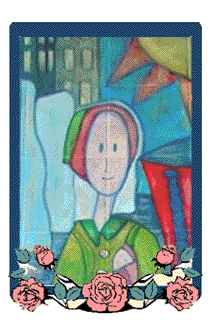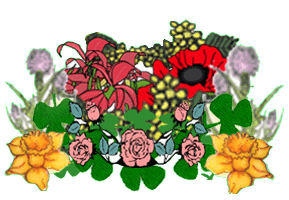Newfoundland War Brides
 |
 |
 |
Roses and Thistles
G.J. CASEY AND MAURA C. HANRAHAN
ANNA BOWEN
Anna's marriage to Peter Bowen, a Newfoundlander serving in the Royal Air Force, took place in Northampton, England, on March 16, 1943. Anna was nineteen and Peter eight years older. The two were very much in love and had planned to marry when Anna turned twenty-one. But His Majesty's government intervened: one winter's day Anna got her "call-Up papers" or conscription documents from the army. Her mother was upset. She had lost her husband to mustard gas in World War I and now was threatened with the absence of her daughter on whom she was economically dependent. When Peter pointed out that married women were never conscripted, the wedding day was immediately set.
Goods were scarce in wartime Britain and everyone was subjected to rations. For Anna this showed a community willing to share and to pull together. During the young couple's courtship, Peter's mother sent food parcels from Newfound¬land. With the wedding on the horizon, Anna's mother saved the dried fruit from these parcels to make the wedding cake. Neighbours chipped in with an ounce of fat, and the butcher donated "two big ox tongues". The food office allowed a maximum of twenty-five people to attend weddings, and despite the fact that Anna was marrying in the Catholic Church, all her staunchly Anglican relatives attended in support. In Newfoundland, life as one half of a "mixed marriage" would not always go so smoothly.
Like most of the war brides, Anna automatically planned to immigrate to Newfoundland following her husband's tour of duty in Britain. When she arrived in St. John's in March, 1946, Anna and Peter lived with his mother and Anna kept the twenty-one room family house. Work was just not available for married women and she had no children; she could easily have lived a very isolated life. However, her role as a war bride remained very much a part of her life after the war, and it was this status that presented opportunities and responsibilities and gave meaning to her life during these first years in a new land. She served on the Women's Auxiliary of the Legion and on the committee of the Rose and Thistle Club, which she helped found, and as well did a great deal of hospital visitation "because don't forget, there was a lot of hospital visitation done with the war brides that were in the hospital because they didn't have any family to visit them. We were a big support group, a wonderful support group we had".
Added to the economic conditions and the new culture and unfamiliar ways of doing things, these women often had other problems in adapting to the new life. As Anna observed in the same interview,
The Rose and Thistle Club, a St.John's social organization for overseas brides, was a saving grace for many of the women as they gradually made their adjustments to life in the New World:
The war brides had had to cope with shortages and rationing in their native lands, and they brought their resourcefulness with them to Newfoundland. Anna recalls selling forget-me-riots for July lone year with Marjorie Power, a war bride from Sussex.The two decided to explore St.John's and they walked the three miles to the fish plant on the Southside Road. Anna claims that the workers there, who were all men in those days, bought every last flower.But these two war brides were shocked to see hundreds of pounds of flatfish or flounder not being processed but being discarded or used for fertilizer. Marjorie insisted that it was an edible and tasty fish, much like the sole that she had been familiar with in Britain. For many months after, the two women would walk over the railway trestle bridge with two carrier bags and fill them with flatfish, provided free by the plant workers. What they did not consume themselves would be distributed to the other war brides at the Rose and Thistle Club.
Before they married, Anna converted to Peter's religion, Roman Catholicism. She explains:
By joining Peter's church, which she felt to be "a duplicate" of her own Anglican faith, Anna thought she would make her married life as uncomplicated as possible.
There was the added bonus in that: "My father-in-law was delighted, Peter had 'saved a soul'. Talk about hero worship, he thought his son was St. Peter!" But all was not sweetness and light, for religion and sectarianism presented problems upon Anna's arrival:
Anna was very upset and offended when her parish priest suggested that she try to convince another war bride in a "mixed marriage" to have her children baptized as Catholics. In addition, another priest told her that she was committing a sin by attending the Rose and Thistle meetings as the club was, he alleged, "a Protestant establishment." Both of these incidents ended in angry verbal exchanges, but Anna held her ground. Furthermore, when Anna arrived in Newfoundland she
The "aside remarks" by her mother-in-law about her English ancestry once angered Anna so that she answered with words I'll never forget":
Again Anna found solace at the Rose and Thistle Club. This club "which had no religious affiliations" was used "as a sounding board for all the difficulties that we encountered in trying to build new lives for ourselves".
Although the activities of the Rose and Thistle Club dwindled over the years as the women assimilated into the community and had more children and less time, Anna insists that the club remained invaluable to her and to many of the other war brides:
To read the complete File see:
Memorial Library
Author: Casey, George J.
Author: Hanrahan, Maura C.
Title: Roses and thistles: Second World War brides in Newfoundland
Journal: Newfoundland Studies, Fall 1994, Vol. 10(2), pp. 240-249.
Subject: WOMEN and WOMEN'S STUDIES
Subject: SOCIAL LIFE and CUSTOMS
Subject: HISTORY-20th Century
Article Type: Article
Note: bib
MUN Holdings: Click here for MUN library holdings:
http://info.library.mun.ca/uhtbin/issn-search2/0823-173

| Yearbook | References | Citizenship | Photo Album | Links |
| Submit Info | Contact Us | Comments |